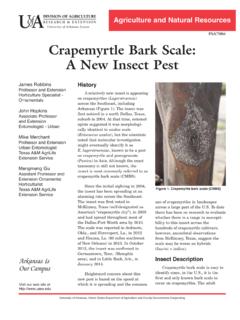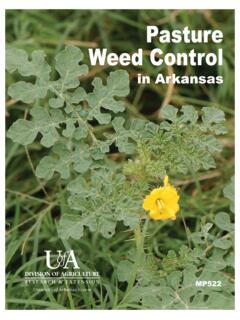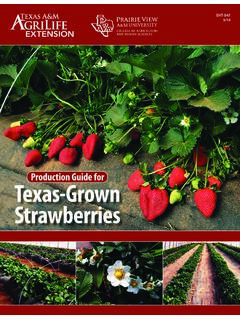Transcription of An Introductory Guide to Strawberry Plasticulture - uaex.edu
1 An Introductory Guide to Strawberry Plasticulture E. Barclay Poling Professor and Extension Specialist (Small Fruits) Department of Horticultural Science, NC State Section 1. Introduction strawberries are one of the most economically important fruit cr ops in North Carolina and throughout the Southeast. In 2001, North Carolina led the Mid-South region with an estimated 1800 acres, followed by Arkansas (500 A) and Virginia (500 A), South Carolina (400 A), Tennessee (350 A), an d Alabama (240 A) (Table 1). Table 1. Strawberry Production (Thou. Acres) Year NC VA TN SC GA AR AL Totals 2001 2000 1999 1998 1997 The 4,040-acre Strawberry Plasticulture industry represented by these seven southeastern states is highly de-centralized and almost entirely based on small family farm units producing several acres of berry production for direct marketing (U -pick, ready-pick, roadside stands, an d farmers markets).
2 The main harvest months fo r this region are April an d May, but coastal regions in Georgia and South Carolina have production beginning in early to mid-March in most years. The primary purpose of this Guide to give an overview of the Strawberry Plasticulture Production System that is now the main commercial growing system for North Carolina an d other states in the Mid-South. Strawberry Plasticulture is technically the annual hill training system in which green Strawberry transplants (fresh dug plants or plugs) are planted in early fall in double rows at densities of approximately 15,000 to 17,500 plants/acre on methyl bromide fumigated, raised beds that are covered with black plastic mulch.
3 It is a relatively recent production technology for our region as it was only first introduced to the Mid-South by researchers at NC State University in the early 1980s. Strawberry Plasticulture has now virtually replaced the older matted row system in our seven-state region. A single acre of Strawberry Plasticulture can be 2 times as productive as an acre of bare- ground matted-row production, but, it is also a production system that is fa r more management-intensive than matted-row. There is considerably less margin for error in regards to soil, crop, pest, frost/freeze and market management decisions and operations. 2 Figure 1. Sandy loam and clay loam soils are ideal for building and shaping the 8 to 10- inch raised beds that are a critical component to success in the Strawberry Plasticulture system.
4 The raised beds are 8-10 i n high, and 28 30 in wide at the base. These beds are fumigated 2-3 weeks prior to transplanting with Met hyl Bromide:Chloropicrin (67:33) at 200 lb/ A in -the-row (shank injection). As the fumigant i s injected, the beds are immediately tarped with an embossed 1 mil black plastic mulch fil m that can be stretched by the mulch laying/fumigation unit to give an extra tight fit over the bed. The black plastic film needs to be in direct contact with the soil (for maximum soil warming to occur in the lat e fal l and winter months). If there are air pockets between the film and the soil, the black plastic will ac tually serve to cool the soil, and plant top-growth and root development will be significantly reduced.
5 In the Strawberry Plasticulture system berries ca n be harvested in just 7 to 8 months after planting in the early fall. Following harvest (early to mid-June), the Strawberry plants are destroyed due to the high ris k of infection with anthracnose fruit rot (Colletotrichum acutatum ) in second-year beds. The plastic beds are sometimes re - utilized for summer/fall vegetable crops, and these crops also would benefit from pre- plant fumigation with methyl bromide fo r strawberries . Yields of approximately 10 tons per acre (20,000 lbs) ca n be realized in this region in good weather years with plastic mulch culture system that involves preplant shank application of methyl bromide + chloropicrin (67% + 33%) at 200 lb/acre formulation (Fig.)
6 1). Production costs for the system are approximately $10,000/acre (See Section on Economics). Assuming an average price of $ (this is a blended price based on 12,000 lb/A of fruit being sold pick-your-own at $ , an d 8,000 lb/A of fruit being sold Ready-Pick at $ ), a grower producing 20,000 lb/A can potentially gross $20,600/A. Because the establishment costs for the Plasticulture system are quite high, it is vital fo r growers to achieve yields of at least 15,000 18,000 lb/acre to be profitable. This works out to a minimum yield of 1 lb per plant (assuming 15,000 plants/acre). There is a relatively high level of ris k associated with Strawberry Plasticulture production erratic weather patterns in some years ( early spring heat wave in April 2002) as well as unpredictable nursery plant quality (the main concern is with anthracnose infection) ca n dramatically reduce marketable yields and profit potential.
7 3 Most growers in our region do not qualify fo r an y form of crop insurance to protect against losses associated with events such as the heat wave in mid-April 2002 that scorched the crops of growers in North Carolina s Coastal Plain and Sandhills ( ). A positive factor in our region is the increasing demand fo r locally grown, farm fresh strawberries . The real challenge for the Strawberry producer is to try to be consistent in his/her production from one year to the next. Important trends: In the last fe w years there have been several developments in the Strawberry Plasticulture industry that have ca used considerable concern. New and potential growers need to be aware of these problems: 1.
8 Highly erratic weather patterns, such as the fall-winter-spring in 2001 and 2002. 2. Difficulties with harvest of Chandler Strawberry were encountered in both the 2001 and 2002 spring season the main problem was the extremely concentrated crop that made it very difficult to locate enough pickers and markets during the peak production period. 3. Pick-Your-Own markets are declining as more customers demand Ready- Pick. Prospective growers need to plan for an adequate labor supply to pick these berries. 4. Increasing problems with anthracnose in plant supplies. The best way to minimize this problem is to use plants from an anthracnose free nursery. 5. Impending cancellation of methyl bromide in 2005 this fumigant is used by nearly 100% of al l commercial Strawberry Plasticulture in the Mid -South.
9 Fig. 2. Increasingly erratic weather patterns have caused many producers to make a fairly expensive investment in row covers for additional protection against advective freezes a s well for added floral development in colder than normal falls. 4 Section 2 Annual Hill Culture As stated in the Introductory section, Strawberry Plasticulture is technically the annual hill training system. The term hill culture refers to a type of Strawberry training system where the runners are either manually or mechanically removed (in summer), or don t develop at al l (fall- winter season). It is a training system that allows only for the growth and development of the mother plant. Hill system transplants are normally set in double rows with plants spaced 12-14 inches in -the-row by 12-14 inches between the row this is variety-dependent as some varieties like Sweet Charlie benefit from closer spac ing than more vigorous varieties like Chandler.
10 Plants are normally set in a staggered pattern (alternate) with the adjacent row as indicated by the illustration in Fig. 3-H. The training systems shown in Figs. 3-D and 3- E are modifications of the older matted row system where mother plants are set in the early spring and allowed to runner . In contrast, any runners that form in the hill system are removed. In actuality, by the time growers in the southeastern Coastal Plain plant in mid-October, there is no runnering at all. Fig. 3. Systems of training strawberries : D. Spaced Row (allows daughter plant development with mother plants set in center); E. Spaced Row (mother plants set near edge of raised bed); F.



















